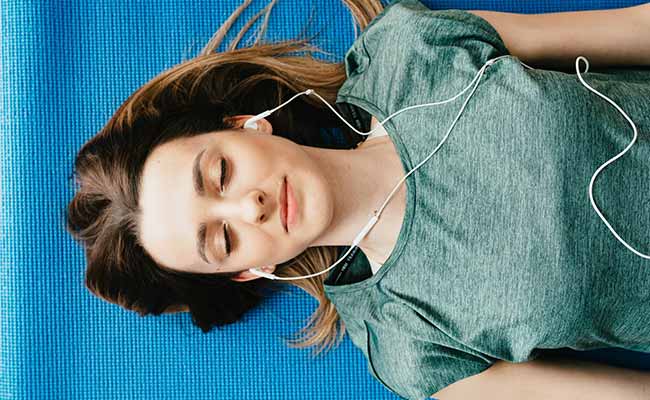Using binaural beats is seemingly very simple. Just like other music, you put on your headphones and press play.
But naturally people still have a lot of questions, usually around how to listen and when – many of which I get via email.
So in this post I am going to share my top tips for getting the best results out of your listening experience, and go into some details about my routine – so you can develop an effective one too.

1. Identify Your Goals
It can be overwhelming to know where to start and what tracks you should buy.
The simple way to approach this is to decide what areas of your life need attention.
What things in your life are currently a problem?
What are your goals?
What areas would you like to improve?
- Perhaps you suffer from anxiety
- Maybe you've been having trouble sleeping lately
- perhaps you like to meditate but you find it boring and quite difficult to sit still
- Maybe having trouble concentrating and focusing on work
Identify the areas you want to improve in and then buy some tracks that will help you.
2. Develop a Listening Routine
So, now you have your tracks, you're wondering when to listen to them.
It's a good idea to start off with a routine of around three tracks per day.
To give you an idea, my day typically starts quite early with me working on the computer. So I tend to listen to tracks that help me get straight into the productivity zone and focus through until lunchtime.
Then, maybe at lunchtime I will eat something first and then do a half an hour deep meditation, or listen to an abundance and prosperity related track with subliminal affirmations – I've really been digging this this year.
In the evening, depending on whether I feel stressed or mentally drained, I will listen to something to chill out, like a Theta track of some sort. Then often I will listen to a track designed to aid sleep before I go to bed, or while in bed while reading a book.
I tend to follow a routine for around two weeks, and then I will swap tracks in and out depending on what my mind state is like and what I feel is required.
A general rule to consider when mapping out your routine is that it isn't a good idea to listen to Beta state tracks in the evening because these promote high-level brain activity at a time when you should be winding down.
And it probably isn't a good idea to listen to Delta state tracks during the day as these may induce tiredness, unless you are looking to have a nap – though in that respect you might be better off using a deep Theta track, as you don't want to fall into a deep sleep and wake up groggy.
3. Keep Consistency
Maintaining consistency is how we get good results in any endeavor in life. And with binaural beats music it's pretty simple to do.
All you have to do is put on your headphones, as you would when listening to any other type of music, so it isn't like you have to make a huge commitment.
But if you want better results, particularly in the case of subliminal messaging entrainment, you really do need to make sure you have a daily routine.
Just like people allocate a slot each day to meditate or exercise, it's a similar concept.
4. What to Do When Listening
One question people usually have is “what should I do while I'm listening. Can I do x, y, z?”
Whatever you're doing while you're listening should complement the listening experience.
So if you're listening to a track designed to help you sleep better, which is most likely going to be a Delta waves track, you don't want to be exercising, because you'll be pulling the brain in two different directions. This is common sense, right?
Conversely, if you're working on the computer, perhaps coding or writing an article, then you could listen to a track designed to help you focus and concentrate, as I mentioned earlier.
There might be some grey areas, depending on the track, but this is a general rule of thumb.
5. Listening Duration
I generally try to listen for more than 15 minutes in a given session but try to do a full 30-minutes. If possible I will listen for an hour – which is most practical when I'm working on a computer or chilling out in the evening.
Again, the general rule of thumb and opinion of most brainwave entrainment experts is that less than 15 minutes will not be very beneficial.
Do take breaks, though. Don't go nuts and start listening for 5-hour marathon sessions, because excessive headphone use can cause headaches.
6. Using Headphones
You need to use headphones because the way binaural beats work is as follows:
The brain requires a frequency to come from the left headphone and the right headphone. The brain takes these two frequencies and interprets a third frequency, which is the mathematical difference between the two. The brain then follows along at that frequency.
This natural occurrence is known as ‘frequency following response'.
Pretty much any headphones will do the job, though of course some headphones are better than others.
If possible try to use closed-back headphones, which offer a more isolated listening experience and do not allow frequencies to leak from the headphones or sound vibrations to come in from the external environment.
I have an article that discusses different types of headphones and models that you might consider. See that here.
7. Using Different Devices (phone, mp3 player, tablet, etc)
Because I listen a lot while I work, I tend to listen through my computer. I have a couple of pairs of different headphones and have a pretty good system that works through my computer and gives me a really good sound.
Without going into too much detail, I have an external sound card that goes into my computer and contains high quality preamps that mean I get better sound.
But you're probably wondering about listening on your phone, tablet or MP3 player, or even burning a CD and plugging your headphones into an old CD player unit.
Any of these listening platforms are perfectly fine. Once you have bought your tracks, download them to your computer and then share them among any devices that you have.
The playback quality of music through phones and iPods and tablets has come a long way and is getting better and better. You will not notice the loss in quality of sound. The only time you will notice this is if you switch from one of these devices to a high-end audio device that is developed for professional listening.
But don't worry about not getting the benefits because you're listening through your phone or an MP3 player. These devices will be fine.
8. Take a Break
The idea of brainwave entrainment is to shift the brain from one state to another, from a negative to a positive state.
For example: If you are suffering from social anxiety and you use a track to help with anxiety before you go out and meet people, you will find that over time you don't need to listen to the track as much before the event as you did in the past, because as the event approaches and you begin to think about it your brain does not shift into an anxious mode like it used to.
You should get to a point where you feel you don't really need it. The effect is cumulative.
However, it is common that we slip back into old patterns of thinking. So if you find yourself being anxious again then you would begin using the track again.
I think one of the positives of taking a break from your binaural beats routine is that this does have the potential for your brain to just get used to hearing these frequencies day after day.
The nature of the human body is that is very adaptable. Taking a break for a week or so and then coming back again and perhaps developing a new routine and listening to some different tracks will definitely be beneficial, and the impact is likely to be greater than just listening day in day out for months on end.
The same can be said for hypnosis and other forms of entrainment.
9. Buying Binaural Beats
Over the years I have purchased from numerous stores and from those promoting “systems”. I bought a lot of crap in the early days and fell for some of the overt marketing hype. I don't want you to do the same. There are three stores I generally recommend for my followers:
- BinauralBeatsMeditation (Brilliant)
- Ennora (Great)
- iAwake (Experimental)
10. Enjoy the Listening Experience!
Lastly, enjoy your listening – this is supposed to be pleasurable.
It's easy to get caught up in the details of how best to listen, looking at the latest research on brainwave entrainment, or debating which headphones are best, etc., but at the end of the day this is just music therapy. It isn't supposed to be complicated.
I usually try to recommend tracks that are wonderful to listen to, that have beautiful compositions and make the listening experience rewarding.
For example, I'm not a fan of the pure binaural beats tones (naked without music), as generally they aren't very appealing. The idea of sound is that we enjoy hearing it.
I often listen to tracks without headphones because I like the soundscape and the composition that the producers put together and want to appreciate it through my speakers. Doing so means you still benefit from the relaxing and potentially healing properties of the music.
In a nutshell: I'm always on a quest to seek out music that I love listening to, and I suggest you do the same.



Annemarie says
Hi, I purchased Holosync about 14 years ago and use this as my default after trying various other companies, I am now 14 years older and need to use it for different reasons, my question is can I use Binaural Beats with hearing aids and will Binaural Beats help with my hearing and cognitive function ?
Thanks
Annemarie
bbfreak says
Hi Annemarie, this is the answer I found in the Holosync FAQ:
As long as you have some hearing, Holosync will work. You don’t even need to have equal hearing in each ear. Any amount of hearing in each ear will be enough. People have even reported results when the hearing was entirely by bone conduction.